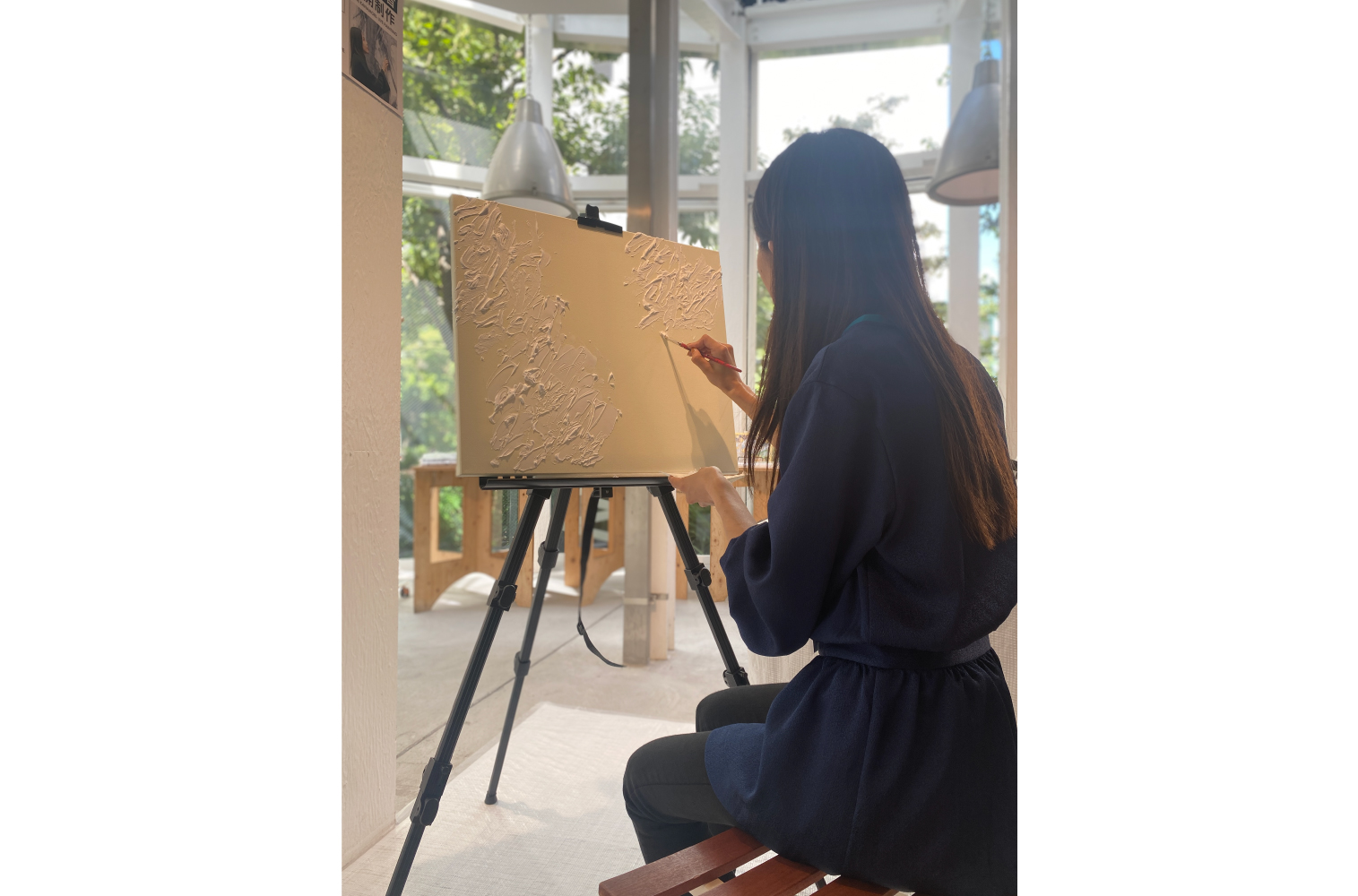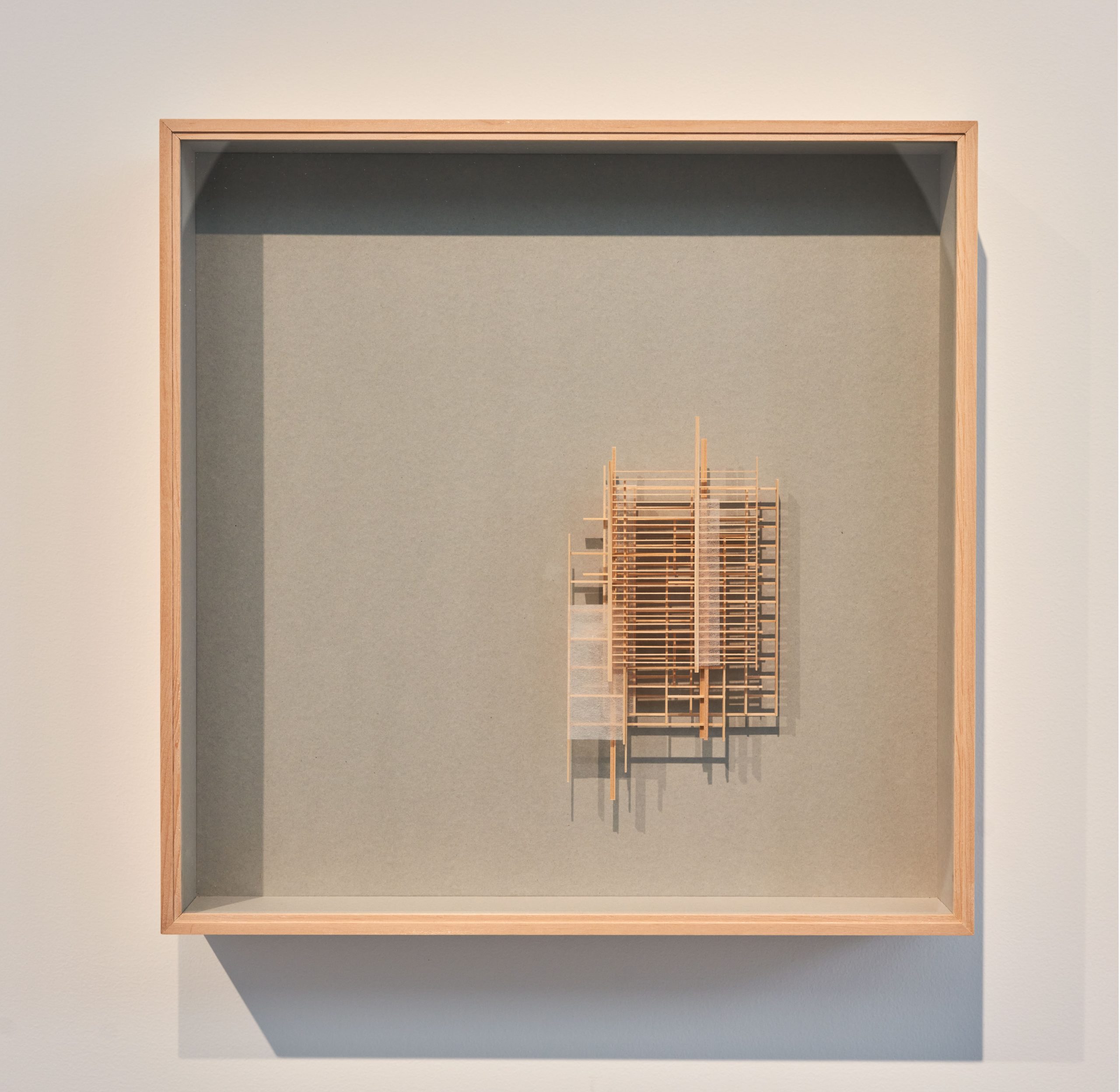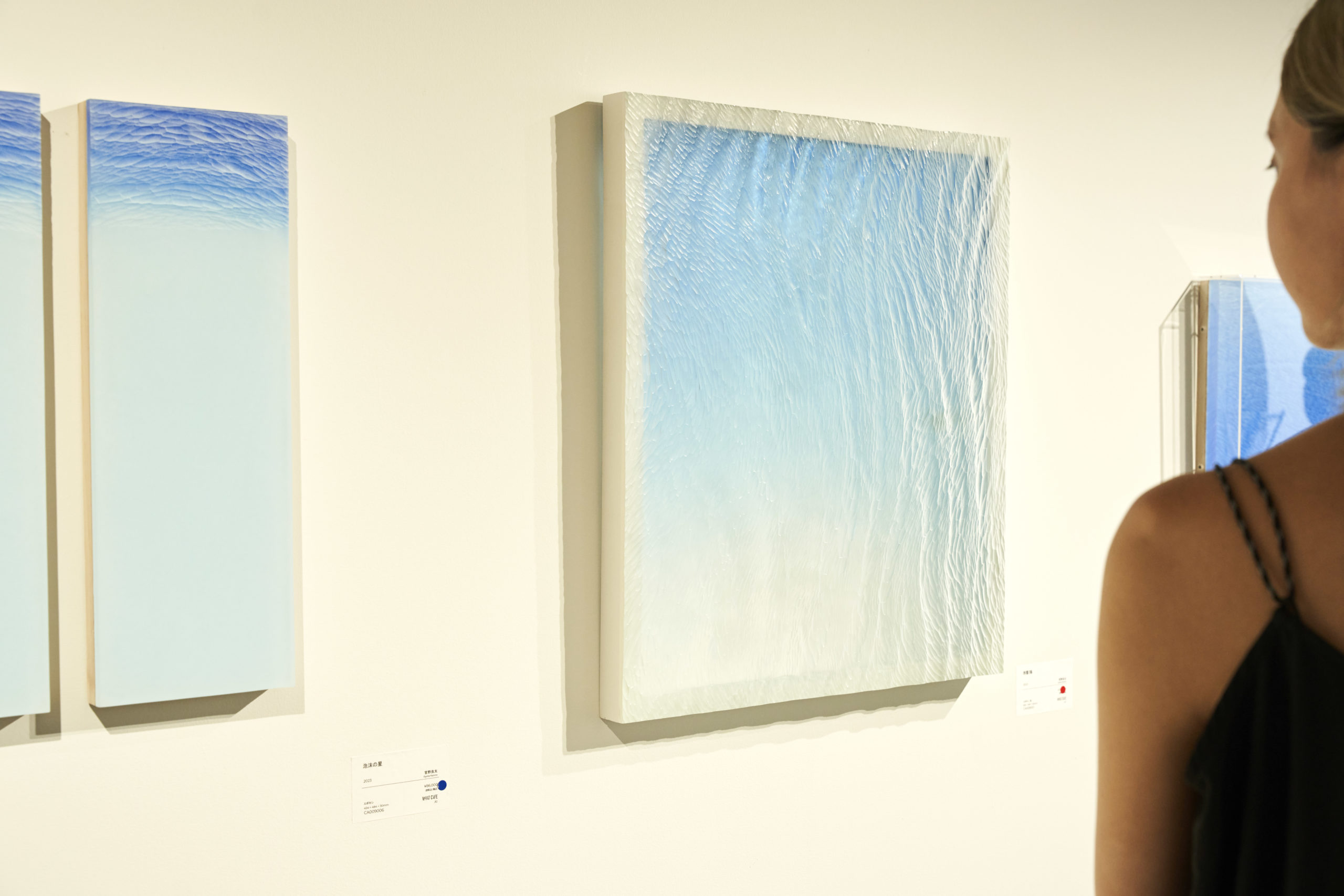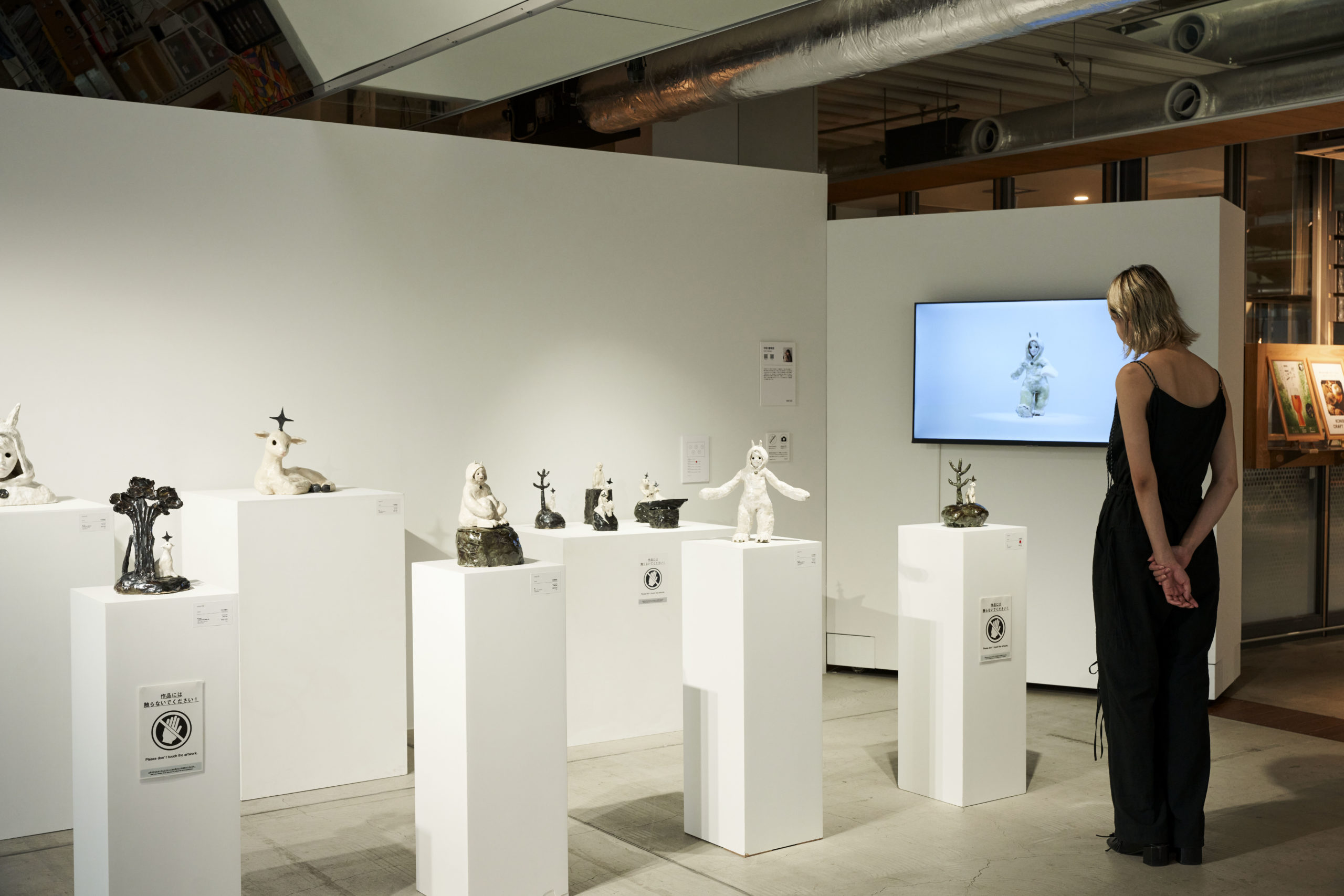展示レビュー
WHAT CAFE EXHIBITION vol.27
WHAT CAFE EXHIBITION vol.27 展示レビュー
WHAT CAFE EXHIBITION vol.27 Review
WHAT CAFE EXHIBITION vol.27 Review
WHAT CAFE EXHIBITION vol.27 Review
2023/08/20 | レビュアー:髙橋雛 レビュアー:Hina Takahashi レビュアー:Hina Takahashi レビュアー:Hina Takahashi
2023年8月4日(金)から8月20日(日)まで、WHAT CAFEにて、アーティスト16名による作品約100点を一同に展示する「WHAT CAFE EXHIBITION vol.27」が開催されました。展覧会のテーマは「ART IS …」。<br /> <br /> 「ART IS …」というテーマには、WHAT CAFEを訪れる人々が自身の「アートとは」について再考し、新たな発見を得る場を提供するという熱意が込められています。展示期間ごとに異なるアーティストの作品が展示され、アーティスト、コレクター、ギャラリーなど、現代アートの関係者やライトアートファンといった多様な人々の「ART IS …」が共有されることで、来場者のアートへの興味関心を深めるきっかけとなることを目指しています。
From August 4 (Fri) to 20 (Sun), 2023, around 100 works by 16 artists were exhibited in WHAT CAFE as part of WHAT CAFE EXHIBITION vol.27. The theme of the exhibition was “Art Is…”<br /> <br /> The theme conveys WHAT CAFE’s desire to offer a space in which visitors can think afresh about what “Art Is” for them, and make new discoveries. For each exhibition, WHAT CAFE exhibits works by different artists, through which a wide variety of people—artists, collectors, gallery curators, and others from the contemporary art world, as well as casual art fans—can share their “Art Is.” Through this, the venue aims to deepen visitors’ interest in art.
From August 4 (Fri) to 20 (Sun), 2023, around 100 works by 16 artists were exhibited in WHAT CAFE as part of WHAT CAFE EXHIBITION vol.27. The theme of the exhibition was “Art Is…”<br /> <br /> The theme conveys WHAT CAFE’s desire to offer a space in which visitors can think afresh about what “Art Is” for them, and make new discoveries. For each exhibition, WHAT CAFE exhibits works by different artists, through which a wide variety of people—artists, collectors, gallery curators, and others from the contemporary art world, as well as casual art fans—can share their “Art Is.” Through this, the venue aims to deepen visitors’ interest in art.
From August 4 (Fri) to 20 (Sun), 2023, around 100 works by 16 artists were exhibited in WHAT CAFE as part of WHAT CAFE EXHIBITION vol.27. The theme of the exhibition was “Art Is…”<br /> <br /> The theme conveys WHAT CAFE’s desire to offer a space in which visitors can think afresh about what “Art Is” for them, and make new discoveries. For each exhibition, WHAT CAFE exhibits works by different artists, through which a wide variety of people—artists, collectors, gallery curators, and others from the contemporary art world, as well as casual art fans—can share their “Art Is.” Through this, the venue aims to deepen visitors’ interest in art.
展示室に設置されているQRコードからは、「心が震えるアートの話をしよう」をテーマに活動する「耳で聴く美術館avi」がアートナビゲーターを務める無料の音声ガイドを聞くことができます。たくさんの文字が並んだ案内を見るとつい背筋が伸びてしまう…そんなときは、作品に集中しながら、優しい声に耳を傾けて鑑賞してみるのも一つの方法です。音声ガイドに従って歩みを進めると、まるでアンビエントミュージックのような滑らかな響きが心に広がる絵画が現れます。
Via QR codes provided in the exhibition space, visitors can listen to a free audio guide hosted by Avi of Audible Museum, an influencer whose motto is “Let’s Talk About Art That Will Make Your Heart Tremble.” When an artwork is accompanied by a large amount of explanatory text, it can feel a bit formal; in these cases, another option is to concentrate on the work while listening to a mellifluous voice. As I explore the gallery while following the audio guide, the works resonate smoothly through me, almost like ambient music.
Via QR codes provided in the exhibition space, visitors can listen to a free audio guide hosted by Avi of Audible Museum, an influencer whose motto is “Let’s Talk About Art That Will Make Your Heart Tremble.” When an artwork is accompanied by a large amount of explanatory text, it can feel a bit formal; in these cases, another option is to concentrate on the work while listening to a mellifluous voice. As I explore the gallery while following the audio guide, the works resonate smoothly through me, almost like ambient music.
Via QR codes provided in the exhibition space, visitors can listen to a free audio guide hosted by Avi of Audible Museum, an influencer whose motto is “Let’s Talk About Art That Will Make Your Heart Tremble.” When an artwork is accompanied by a large amount of explanatory text, it can feel a bit formal; in these cases, another option is to concentrate on the work while listening to a mellifluous voice. As I explore the gallery while following the audio guide, the works resonate smoothly through me, almost like ambient music.
金森朱音さんは、「全て文字を書くということ」を意識して絵画を制作しています。今回出展された「生きる」シリーズは、行書体や総書体などさまざまな形で画面上に「生きる」という文字が刻まれており、その文字を探していく行為は、まさに私たちが迷いながらも進んでいく日々のようです。展示会場にさまざまなコンセプトの作品があるように、私たちの生き方にもいろいろな道がある、ということを思い出させてくれます。私たちが当たり前に行っている行動や、日常で気にも止めない風景に、改めて立ち止まって考えるきっかけを提供してくれるのもアートの魅力のうちのひとつですよね。
For Akane Kanamori, creating images always comes down to writing characters. In Ikiru, the series exhibited here, the characters 生きる (ikiru, which means “living”) are inscribed on the canvas in a range of calligraphic styles. Our search for those characters mirrors our attempts to find a way through our lives, day by day. It reminds us that there are many different ways to live our lives, just as there is a variety of concepts behind the works in the exhibition space. One of the appealing things about art is the way it makes us stop and think again about our everyday behavior, or about things we see so often we don’t even notice them anymore.
For Akane Kanamori, creating images always comes down to writing characters. In Ikiru, the series exhibited here, the characters 生きる (ikiru, which means “living”) are inscribed on the canvas in a range of calligraphic styles. Our search for those characters mirrors our attempts to find a way through our lives, day by day. It reminds us that there are many different ways to live our lives, just as there is a variety of concepts behind the works in the exhibition space. One of the appealing things about art is the way it makes us stop and think again about our everyday behavior, or about things we see so often we don’t even notice them anymore.
For Akane Kanamori, creating images always comes down to writing characters. In Ikiru, the series exhibited here, the characters 生きる (ikiru, which means “living”) are inscribed on the canvas in a range of calligraphic styles. Our search for those characters mirrors our attempts to find a way through our lives, day by day. It reminds us that there are many different ways to live our lives, just as there is a variety of concepts behind the works in the exhibition space. One of the appealing things about art is the way it makes us stop and think again about our everyday behavior, or about things we see so often we don’t even notice them anymore.
会期中には金森さんによるライブペインティングも開催されました。
Live painting was also performed during the exhibition period.
Live painting was also performed during the exhibition period.
Live painting was also performed during the exhibition period.
抽象度が高い作品たちに身を委ねながら歩みを進めると、描かれているモチーフの輪郭が徐々に具体的になっていくことに気が付きます。<br /> <br /> 会場の中でもひときわ凛とした存在感を放つのは、建築家としても活躍する足立真輝さんの作品です。これらのシリーズは長い間住居や環境を形作ってきた紙や木などの身近な素材を用いており、直線的で抽象的なモチーフの重なり合いが過去の記憶や懐かしさと結びつく、繊細で独特な魅力を放っています。建築模型の一部のようにも見える作品を眺めていると、天井に鏡が並んだWHAT CAFEの建物も、不思議な作りだな、とふと気になってきたり…。アートを通じてさまざまな興味を持つ過程も楽しい体験の一つです。<br />
As I advance, surrendering myself to these highly abstract works, I notice that the motifs are gradually taking on more defined forms.<br /> <br /> The works of Masaki Adachi, who is also an architect, stand out from the rest of the exhibition for their air of refinement. In his series, he uses familiar materials like paper and wood—long used to construct our homes and environments—to create layers of abstract, straight-lined motifs, which give off a distinct, delicate charm redolent of nostalgia and memories of the past. As I look at his works, which resemble sections of architectural models, it suddenly occurs to me how strange the WHAT CAFE building itself is, what with its mirrors in the ceiling… Another fun thing about art is the way it helps you develop a range of interests.<br />
As I advance, surrendering myself to these highly abstract works, I notice that the motifs are gradually taking on more defined forms.<br /> <br /> The works of Masaki Adachi, who is also an architect, stand out from the rest of the exhibition for their air of refinement. In his series, he uses familiar materials like paper and wood—long used to construct our homes and environments—to create layers of abstract, straight-lined motifs, which give off a distinct, delicate charm redolent of nostalgia and memories of the past. As I look at his works, which resemble sections of architectural models, it suddenly occurs to me how strange the WHAT CAFE building itself is, what with its mirrors in the ceiling… Another fun thing about art is the way it helps you develop a range of interests.<br />
As I advance, surrendering myself to these highly abstract works, I notice that the motifs are gradually taking on more defined forms.<br /> <br /> The works of Masaki Adachi, who is also an architect, stand out from the rest of the exhibition for their air of refinement. In his series, he uses familiar materials like paper and wood—long used to construct our homes and environments—to create layers of abstract, straight-lined motifs, which give off a distinct, delicate charm redolent of nostalgia and memories of the past. As I look at his works, which resemble sections of architectural models, it suddenly occurs to me how strange the WHAT CAFE building itself is, what with its mirrors in the ceiling… Another fun thing about art is the way it helps you develop a range of interests.<br />
展示空間自体も楽しみながら鑑賞を続けると、日差しを背負って眺めた、ある日の水面のきらめきを思い出すような作品が目に入ります。<br /> 官野良太さんは、エポキシ樹脂と呼ばれる透明樹脂を削る角度や磨きの強さを調整することによって制作しており、これらは日常にある光の美しさを画面に閉じ込めるだけには留まらず、照らす光の反射や透過を含めて成り立つ、「光の彫刻」ともいえる作品です。私が取材に伺った会期後半には、全点が既に売約済。購入なさったみなさんがどこに作品を飾るのか、自然光に気持ちよく照らされた作品はどんな表情を見せるのか、と想像が膨らみます。<br />
As I continue around the venue, appreciating the space itself, I come across works that evoke a memory of looking at the play of light on water, the sun behind me.<br /> <br /> Ryota Kanno works with epoxy resin, a kind of transparent resin, carving angles into the material and playing with the intensity of its sheen. His works can be described as “light sculptures”: not only do they capture the beauty of everyday light within their surface, they also take shape from the way light is reflected by and transmitted through them. When I visit toward the end of the exhibition, all his works have already been sold. I start imagining where the buyers will display them, and how they will look when attractively illuminated by natural light.<br />
As I continue around the venue, appreciating the space itself, I come across works that evoke a memory of looking at the play of light on water, the sun behind me.<br /> <br /> Ryota Kanno works with epoxy resin, a kind of transparent resin, carving angles into the material and playing with the intensity of its sheen. His works can be described as “light sculptures”: not only do they capture the beauty of everyday light within their surface, they also take shape from the way light is reflected by and transmitted through them. When I visit toward the end of the exhibition, all his works have already been sold. I start imagining where the buyers will display them, and how they will look when attractively illuminated by natural light.<br />
As I continue around the venue, appreciating the space itself, I come across works that evoke a memory of looking at the play of light on water, the sun behind me.<br /> <br /> Ryota Kanno works with epoxy resin, a kind of transparent resin, carving angles into the material and playing with the intensity of its sheen. His works can be described as “light sculptures”: not only do they capture the beauty of everyday light within their surface, they also take shape from the way light is reflected by and transmitted through them. When I visit toward the end of the exhibition, all his works have already been sold. I start imagining where the buyers will display them, and how they will look when attractively illuminated by natural light.<br />
「かわいい!」とスキップして近づきたくなるような村上生太郎さんの作品は、一見CGのように平面的にデフォルメされたモチーフが、間近で見ると、実は色鉛筆で描かれているものだと気付きます。テキスタイルデザインに興味があった学生時代の影響もあり、モチーフは実際の静物とは異なる色合いで大胆に構成されているにもかかわらず、色面を数センチごとのブロックに分けて塗ることで生まれる独特な立体感と、画面上を流れるような刺繍のようにも見える筆致が、作品に温かみを与えています。<br />
I hop over to the next series of works, drawn in by how pretty they are. At a glance, Shotaro Murakami’s works look like CGI, with their motifs distorted across the surface, but on closer inspection, they turn out to be drawn with colored pencils. They reflect the influence of the artist’s interest in textile design during his student years. He generates a particular sense of volume through the way he separates colors into blocks of a few centimeters, notwithstanding the fact that the bold tones he uses are different from real still lifes, and his touch flows across the surface like embroidery; these techniques lend a warmth to his paintings.<br />
I hop over to the next series of works, drawn in by how pretty they are. At a glance, Shotaro Murakami’s works look like CGI, with their motifs distorted across the surface, but on closer inspection, they turn out to be drawn with colored pencils. They reflect the influence of the artist’s interest in textile design during his student years. He generates a particular sense of volume through the way he separates colors into blocks of a few centimeters, notwithstanding the fact that the bold tones he uses are different from real still lifes, and his touch flows across the surface like embroidery; these techniques lend a warmth to his paintings.<br />
I hop over to the next series of works, drawn in by how pretty they are. At a glance, Shotaro Murakami’s works look like CGI, with their motifs distorted across the surface, but on closer inspection, they turn out to be drawn with colored pencils. They reflect the influence of the artist’s interest in textile design during his student years. He generates a particular sense of volume through the way he separates colors into blocks of a few centimeters, notwithstanding the fact that the bold tones he uses are different from real still lifes, and his touch flows across the surface like embroidery; these techniques lend a warmth to his paintings.<br />
片山穣さんの作品は、一部のタイトルが不思議な数字の羅列になっており、その数字を地図アプリに打ち込むと、モデルとなったエリアが表示されるとのこと。実際に試してみると、画面の中に描かれた建物が現れました!作品のモデルとなった場所に足を運ぶこともできる、というのは新しい体験ですよね。
Some of Joe Katayama’s works have a mysterious chain of numbers for titles. The idea is that if you type them into a map app, it displays the area on which he modeled the work. When I try it, the building depicted in his work appears! To be able to visit the place that served as inspiration for the art is a new experience.<br />
Some of Joe Katayama’s works have a mysterious chain of numbers for titles. The idea is that if you type them into a map app, it displays the area on which he modeled the work. When I try it, the building depicted in his work appears! To be able to visit the place that served as inspiration for the art is a new experience.
Some of Joe Katayama’s works have a mysterious chain of numbers for titles. The idea is that if you type them into a map app, it displays the area on which he modeled the work. When I try it, the building depicted in his work appears! To be able to visit the place that served as inspiration for the art is a new experience.
ろうを落とした箇所だけが染まらないという特性を活かし、綿の布を染めて描く「ろうけつ染め」という技法を使って描く彼の作品は、独特のフラットな質感が特徴的です。色が染み込んだ布の表情を見ていると、まるで彼が大切にする「チル」というキーワードそのもののように、心にまで更に風景が染み渡っていくかのような感覚を覚えます。
Katayama uses a technique called rōketsuzome or “wax resist-dyeing”: he dyes cotton cloth, applying wax to the parts where he doesn’t want the dye to permeate the fabric. His works have a characteristic flat texture. Looking at how the color has dyed the cloth, I feel almost as though the scenery has seeped into my very core. It makes me think of that keyword so important to Katayama: “chill
Katayama uses a technique called rōketsuzome or “wax resist-dyeing”: he dyes cotton cloth, applying wax to the parts where he doesn’t want the dye to permeate the fabric. His works have a characteristic flat texture. Looking at how the color has dyed the cloth, I feel almost as though the scenery has seeped into my very core. It makes me think of that keyword so important to Katayama: “chill
Katayama uses a technique called rōketsuzome or “wax resist-dyeing”: he dyes cotton cloth, applying wax to the parts where he doesn’t want the dye to permeate the fabric. His works have a characteristic flat texture. Looking at how the color has dyed the cloth, I feel almost as though the scenery has seeped into my very core. It makes me think of that keyword so important to Katayama: “chill
ぐるりと会場を一周し戻ると、幼少期よりバレエを習いプロを目指していた経験から、舞台の上で演じる際に感じた、演技の器として立ち振る舞う役の「空虚さ」を、空洞をもつ陶器に重ね合わせて表現する、中田愛美里さんの陶器作品シリーズが目に入ります。一見可愛らしい作品の内側が空っぽであることに気がつくと、その空虚には何が表されているのかと、覗き込んで感じてみたくなることでしょう。同会場に展示されている、陶器をアニメーションで動かす映像作品は、アートの見た目の美しさを楽しむだけではなく、そのキャラクターが存在する世界やコンセプトを想像する手助けをしてくれます。<br />
As I complete my tour of the venue, I come across a series of ceramic sculptures by Emiri Nakada. Having trained since infancy to become a professional ballerina, when onstage Nakada would feel the “emptiness” of acting as a vessel for the performance, and she conveys this “emptiness” by overlaying it onto her ceramics, which are hollow. At first her works look cute, but when I realize that they are empty inside, I get this great urge to peek inside and see what is being expressing by that emptiness. Alongside is screened a film in which the sculptures move through animation. The film helps us not only to appreciate the outward beauty of art, but also to imagine the concept, the world in which these characters live.<br />
As I complete my tour of the venue, I come across a series of ceramic sculptures by Emiri Nakada. Having trained since infancy to become a professional ballerina, when onstage Nakada would feel the “emptiness” of acting as a vessel for the performance, and she conveys this “emptiness” by overlaying it onto her ceramics, which are hollow. At first her works look cute, but when I realize that they are empty inside, I get this great urge to peek inside and see what is being expressing by that emptiness. Alongside is screened a film in which the sculptures move through animation. The film helps us not only to appreciate the outward beauty of art, but also to imagine the concept, the world in which these characters live.<br />
As I complete my tour of the venue, I come across a series of ceramic sculptures by Emiri Nakada. Having trained since infancy to become a professional ballerina, when onstage Nakada would feel the “emptiness” of acting as a vessel for the performance, and she conveys this “emptiness” by overlaying it onto her ceramics, which are hollow. At first her works look cute, but when I realize that they are empty inside, I get this great urge to peek inside and see what is being expressing by that emptiness. Alongside is screened a film in which the sculptures move through animation. The film helps us not only to appreciate the outward beauty of art, but also to imagine the concept, the world in which these characters live.<br />













